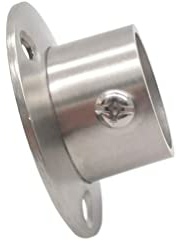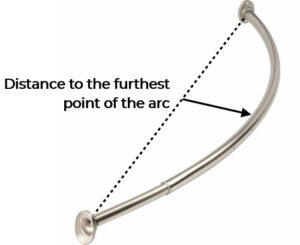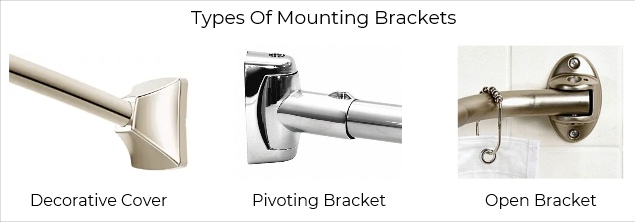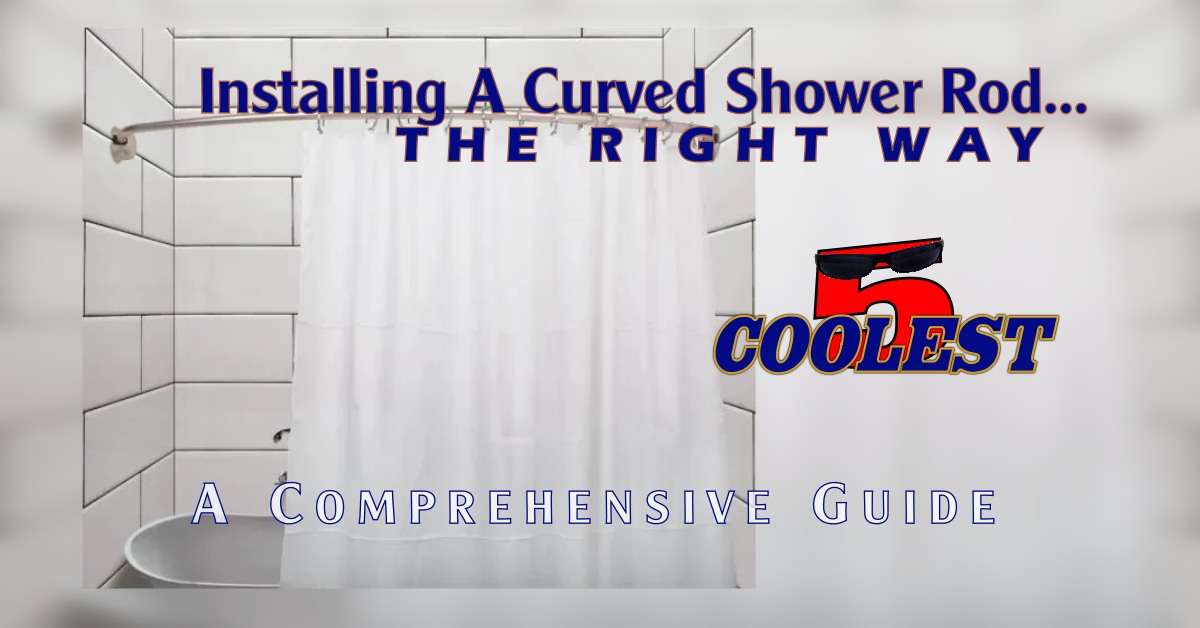Installing A Curved Shower Rod The Right Way
Last updated on January 21st, 2023 at 02:26 pm
Curved Shower Rod Installation
So you’re interested in getting a curved shower curtain rod for your bathroom. Or maybe you’ve already purchased one and are ready get started.
You may not quite be sure what comes next, or you just want more information before you proceed.
If you are wondering just what it involves when installing a curved shower rod, I have you covered in this article. I will let you know:
- How to get prepared before you begin your installation
- The first steps to getting started.
- A blow-by-blow guide to help keep you on track.
- And how to complete your project.
So let’s jump right into it.
Installing a Curved Shower Rod
What To Do First
Let’s make sure that you have the correct tools to complete the job. Here’s some common tools you will want to have on hand:
▶ a screwdriver (best to have a phillips and flat-head both)
▶ a level
▶ a drill (preferably cordless, but not required)
▶ a pair of adjustable pliers
▶ and a measuring tape.
Just to be super prepared and ready for anything, you might also want to have:
▶ a hammer
▶ an awl
▶ a hex key set
▶ pencil and paper
▶ spackling compound
▶ and a putty knife.
Now that you have everything that you will need to make this go smoothly, let’s take a look at the most important step in the whole process.
Measuring
In my opinion measuring is the most important part of the installation. If correct and accurate measurements are not taken to begin with, the process will not be finished very well, if it can be finished at all.
There are a lot of articles and videos online about this type of installation. But most of them leave out the details about taking measurements. They begin with “place the bracket in the desired location…”, and they move on from there.
Don’t get ahead of the game.
How can you know the desired location for the bracket if you haven’t taken a good look at your application, and made some solid measurements? Please keep reading and I will help you make sure you can get it done right.
Take A Look At Your Existing Shower Rod
If you are replacing an existing, straight shower rod it is a good idea to take a look at it before you remove it. While it is still in place take a quick measurement from the center of the rod to the top of your tub and from the center of the rod down to the floor. If you’re able to reach it you can also measure from the centerline of the rod up to the ceiling.
One of these surfaces may be where you will measure from for the new bracket location. Write these measurements down so you will be able to reference them a little later.
This would also be a good time to use your level to find out if your floor, the top of your tub, and the ceiling are level or not. Whichever surface is actually level may be the best one to measure from. (Take a look at the Coolest 5 Cross Line Laser Levels.)
Take a look at the length of your shower curtain and liner as well. If you plan to keep your existing shower curtain and liner you will need to have 3-4 inches or more of length past the top of the tub. This is because the arc of the curved shower rod will extend beyond the edge of the tub and pull the curtain and liner a little further up than the old straight rod did.
NOTE: If your current shower curtain and liner do not have that much room at the bottom you may want to think about getting a new Extra Long Shower Curtain and Liner. You will need 3-4 inches of your liner extending into the tub. Any less than that and it may pull out of the tub while you are showering and let water leak onto your bathroom floor.
If the liner is longer than that, make sure it doesn’t extend too far or bunch up into the tub. This could pose a tripping hazard and may be dangerous.
Continue Measuring
Mark on the wall the center-line of your existing shower rod. This can be a good reference later when you begin putting the new rod in place. You may end up mounting it higher or further in, but it will still be a good reference point. And make sure to mark that in pencil so you can erase it later.
Also, while the old rod is still in place, notice where it is located in relation to the front of your tub. Most likely it is directly above the front of the outer edge of your tub. This observation will come in handy later when we begin to mount the new rod.
Remove Your Old Rod
This step will depend upon what type of rod you already have. If it is a tension rod you may just be able to compress one end of the rod into the other, where the two sections of the rod join together, and it will come down.
If it is a mounted rod you will need to get the rod out and then remove the mounting brackets.
For some mounted rods the ends will just fit right into the mounting bracket. In this case you can rotate the smaller portion of the rod so it adjusts into the larger portion, drawing it in and making it shorter. This will allow the rod to come out of the mounting brackets.
Some mounting types will have a decorative cover over the brackets on each end. So you will need to loosen those covers and slide them out of the way.
Often the mounting brackets will have a set screw holding the rod in place. This maybe be a typical phillips head screw, or it may be an allen wrench or hex key screw. So you may need to have a set of hex keys handy.
screw holding the rod in place. This maybe be a typical phillips head screw, or it may be an allen wrench or hex key screw. So you may need to have a set of hex keys handy.
Loosen the set screw on both ends before trying to take either end out of the mounting bracket. If you take one end out and let it hang while the other end is still fixed, it will pull the screws out of the wall. That will make for a nasty repair job that you don’t want to have to do.
Once both set screws are loosened you can begin to screw the smaller section of the rod into the larger section and it will come out of the brackets.
Assemble The New Rod
Assemble the new curved shower curtain rod per the instructions included. This will allow you to hold the rod up to get a better idea of the where you want to mount it. It will also allow you to determine if all of the required parts are included. If you have a helper or someone with you it will make this and some of the other steps easier.
Marking Bracket Location
You most likely won’t be able to use the holes from the old mounting brackets for your new ones. The distance between the holes will probably be different. And the location of your new mounting brackets is probably going to change.
Where To Place The New Brackets
 Determining the new location of your mounting brackets will depend on the arc of your new shower rod. You will need to measure the distance from a straight line between the two mounting brackets to the mid-point of the arc of the rod. (see image) Then you will want to split the difference using the front edge of your tub as a reference.
Determining the new location of your mounting brackets will depend on the arc of your new shower rod. You will need to measure the distance from a straight line between the two mounting brackets to the mid-point of the arc of the rod. (see image) Then you will want to split the difference using the front edge of your tub as a reference.
If the distance you measured is 6 inches then the mid-point horizontally of the curved rod should should extend three inches past the outside edge of the tub.
This is where you may be able to use the old mounting bracket holes as a reference. If they were aligned with the front edge of the tub, then you can measure three inches (or whatever your measurement may be) behind them, into the shower/tub enclosure, and begin marking for your new bracket there.
Mounting The New Rod Higher Or Lower
There may be a reason that you will need to mount the brackets to the wall higher or lower than the old brackets. They might need to be higher so you can mount them into the drywall rather than tile. (Again, if you have to mount it higher make sure your shower curtain and liner are long enough.)
You may need to mount them lower. Perhaps if your shower curtain and liner are not long enough and you are unable to get new ones. If the mounting point is lower than the original, be very sure that it is not so low that anyone in your household will will have to duck under it or possibly hit their head on the rod when getting into the shower.
Drill The Holes
Once you have determined the location of the new mounting brackets you can mark the holes with a pencil while holding the bracket in place. If you do have an awl, you can use it to punch a starter hole in the drywall and make it easier to drill the pilot holes.
The instructions that come with your shower rod should indicate the size of the wall anchors included, and what size pilot hole to drill. Find the correct size drill bit and drill the holes.
Tap the wall anchors into the holes with your hammer so they are flush, or nearly so, with the wall.
Mount The Brackets
Now hold the mounting bracket so the holes line up with the wall anchors, and tighten the screws. DO NOT OVER-TIGHTEN THE SCREWS. This can distort the anchors and drywall and weaken the mounting.
Do this for both mounting brackets.
A NOTE ABOUT WALL ANCHORS: Wall anchors, for drywall and tile both, come in many types. If you are worried that the anchors that came with your new shower rod might not be sufficient, take a trip to your local hardware store and get some anchors that will support more load. You should be able to get them for the same size screw that came with your rod. But that extra little assurance might set you mind at ease.
Insert Shower Rod
Since you assembled the new rod earlier it should be close to the correct length for your tub/shower opening.
Slip one end of the rod into one the corresponding mounting bracket. Then slip the other end into its bracket. This is where a helper will come in handy again.
Also, if your mounting brackets have decorative covers. slip those onto the rod before inserting into the mounting brackets.
Be sure to notice how far the rod inserts into the mounting bracket. If it is not far enough for the set screw to tighten down, you may need to adjust the rod out a bit.
Or if it is adjusted to long, you can screw the rod in and shorten it to the proper length. Then you can tighten down the set screws to secure the rod.
Some mounting brackets are open, or exposed. (See image below) You may have to line the end of the rod up with the bracket and insert a pin or screw of some sort. Then align the other side and repeat.
When both ends are in place, tighten the mounting brackets to secure your rod.

Hang Shower Curtain And Liner
Once the rod is in place and securely tightened down, you can put your shower rings on the rod and hang your shower curtain and liner.
Take a good look once the curtain is hung and make sure it looks level and the curtain and liner length are correct.
Conclusion
Once you’ve cleaned up the area and put all the tools away you can step back and enjoy the look of your newly installed curved shower curtain rod. You’ll also have the satisfaction of installing it yourself and having done an excellent job of it.
But when you take your first shower after installing it, that is when you will be amazed at all the room that is added to your shower space, and how great of a feeling that it is.
Got any questions? Please send me an email (info [@] coolest5.com) and I will be happy to provide the best answer that I can.
Have you already installed one of these type of shower rods and have some insights or great tips to share? Send me a message and let me know. You might have some great tips that I can add here to help other users.
I hope this article has been helpful. Best of luck with your installation. And I wish you many years of enjoyment once it is completed.

